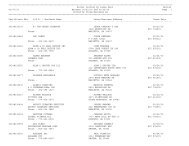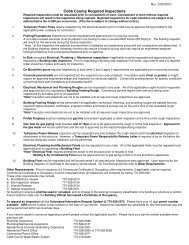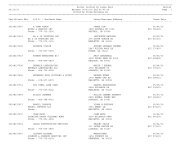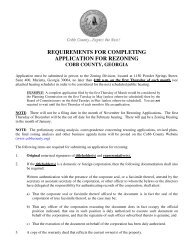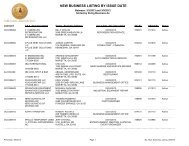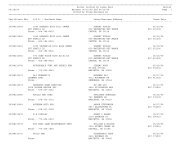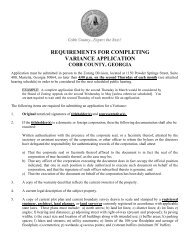State Route 6 Corridor Study Final Report - Cobb County Government
State Route 6 Corridor Study Final Report - Cobb County Government
State Route 6 Corridor Study Final Report - Cobb County Government
Create successful ePaper yourself
Turn your PDF publications into a flip-book with our unique Google optimized e-Paper software.
3.2.2.1 <strong>Corridor</strong>-wide Operational Improvements<br />
The following operational improvements are recommended for the entire corridor.<br />
� Develop truck friendly lanes with weigh in‐motion and signal priority vehicle<br />
control technology<br />
A major corridor need is to provide travel capacity for both passenger vehicles and<br />
large trucks hauling freight. Accommodating heavy truck volumes and general<br />
purpose traffic volumes can be a challenge. Throughout the study, stakeholders and<br />
the public consistently listed high volume truck traffic SR 6 as a concern for safety and<br />
congestion. The ARC Regional Freight Mobility Plan indicated overall in the Region, total<br />
freight tonnage is projected to increase by 78 percent between 2005 and 2030. 5 Within<br />
the SR 6 corridor study area, the Norfolk Southern Whitaker Intermodal Terminal is<br />
slated for expansion. According to Norfolk Southern officials, the Terminal is built out<br />
at 60 percent, so a planned full build‐out of the facility will send more large trucks onto<br />
SR 6.<br />
In order to provide some separation between large trucks and general purpose traffic, it<br />
is recommended that the outside lane on SR 6 in each direction be widened to 13 feet.<br />
The wider outside travel lane would increase the buffer between the outside lane and<br />
adjacent lanes. The wider outside lanes would be coupled with Intelligent<br />
Transportation System (ITS) technologies as appropriate: weigh‐in‐motion detection<br />
and signal priority. These technologies could decrease congestion, delay, and red light<br />
running for trucks at signalized intersections along the SR 6 corridor with roadway<br />
grades that are five percent or greater.<br />
Possible technologies for consideration include wireless magnetic sensors or in‐ground<br />
sensors. Wireless magnetic sensors are able to identify vehicle classification, vehicular<br />
speeds, and traffic volumes and can be adapted to modify green time at signalized<br />
intersections. In‐ground fiber optic load sensor systems detect when the balance of<br />
traffic volumes in stopped condition exceeds a defined threshold and changes the traffic<br />
signal at the intersection. These systems address congestion relief and truck signal<br />
priority in order to reduce idling and delays and prevent red light running.<br />
5 Atlanta Regional Commission, Regional Freight Mobility Plan, page 9.<br />
<strong>Final</strong> <strong>Report</strong> 3‐17<br />
January 2008



